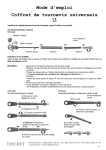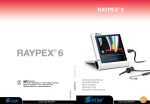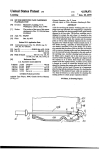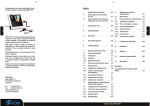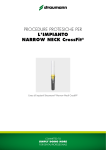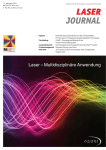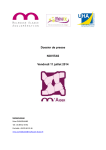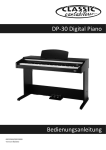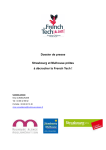Download 000646ex - bredent GmbH & Co.KG
Transcript
D Gebrauchsanweisung Dürr Systemhygiene ID212/220 Dürr Dental Septanin Bohrerbad Gaba Sekudrill Henkel Micro 10plus Micro-Mega 7. Technische Daten Material: gehärteter Edelstahl, mit Industriediamanten besetzt Schaftdurchmesser: 1,6 mm M ä W Bohrerbad neu Müller & Weygandt Kent Dental Kentocid Nordenta 8. Verwendete Symbole Chargenbezeichnung Promed Bohrerbad Promed Grotanat-Bohrerbad Schülke & Mayr Kent Dental Kentocid Nordenta FG-Instrumente Promed Bohrerbad Promed Bitte diese Gebrauchsanweisung vor dem Produkteinsatz ausführlich lesen! Grotanat-Bohrerbad Schülke & Mayr Für Schäden, die durch Nichtbeachtung dieser Gebrauchsanweisung entstehen, lehnt der Hersteller jede Haftung ab. 1. Produktbeschreibung Die FG-Instrumente dienen im Rahmen der zahnärztlichen Präparationstechnik zum Substanzabtrag von Zahnschmelz und Dentin. Hierbei kann es sich sowohl um eine Kronenstumpfpräparation als auch um eine Kavitätenpräparation handeln. Desweiteren lassen sich die FG-Instrumente zur mechanischen Bearbeitung von Kunststoffen, Edelmetallen oder sonstigen im Mund befindlichen Werkstoffen einsetzen. Für die unterschiedliche Anwendung bzw. für die Anwendungsbreite sind die Instrumente nach der ISO-Norm diamantiert. 2. Indikation Zum Substanzabtrag von Zahnschmelz und Dentin, sowie von sämtlichen im Mund befindlichen Materialien. 3. Kontraindikation Nach gegenwärtigem Kenntnisstand sind keine Kontraindikationen bekannt. 4. Gefahren- und Sicherheitshinweise Beim Einsatz von rotierenden FG-Instrumenten innerhalb und außerhalb der Mundhöhle eine Schutzbrille und einen Mundschutz tragen. 5. Lagerungs- und Haltbarkeitshinweise Lagerung Die FG-Instrumente trocken und bei Zimmertemperatur lagern. Haltbarkeit Es besteht kein Verfalldatum. 6. Anwendung 6.1 Reinigung Vor Erstgebrauch das Instrument reinigen (siehe Punkt 6.3) 6.2 Bedienung Die FG-Instrumente unter Berücksichtigung der Einsatzbereiche und Gefahrenhinweise bedienen. Eine sachgerechte Handhabung der nötigen Antriebsgeräte wird vorausgesetzt. Folgende Drehzahlen werden für die FG-Instrumente bei mittlerer Anpresskraft zwischen 0,2 N und 2 N und einer Spraydurchflussmenge von mindestens 50 ml/min empfohlen: Größe U/min 004 – 011 150.000 – 75.000 012 – 016 110.000 – 55.000 018 – 023 85.000 – 30.000 024 – 027 75.000 – 30.000 033 – 055 45.000 – 18.000 6.3 Pflege (Desinfektion, Reinigung und Sterilisation) Achtung: Sterilisation ist kein Ersatz für Sauberkeit! Die Instrumente nach dem Gebrauch in ein Bohrerbad mit geeigneter Desinfektions- und Reinigungsflüssigkeit legen. Anschließend die Instrumente manuell unter fließendem Wasser bzw. im Ultraschallbad oder im Thermodesinfektor reinigen. Nach Beendigung des Reinigungsverfahrens die Instrumente sofort mit einem weichen Textiltuch oder der Druckluftpistole trocknen. Nach der Desinfektion und Reinigung die Instrumente im Autoklaven, Chemieklaven oder im Heißluftsterilisator sterilisieren. Die Instrumente vor der Sterilisation in ein keimdichtes sterilisationsgerechtes Behältnis oder eine sterilisationsgerechte Folie geben. Nach der Sterilisation die Instrumente in dem Behältnis oder der Folie trocken und staubfrei lagern. Desinfektions- und Reinigungsflüssigkeiten für rotierende Instrumente (nach Empfehlung der Deutschen Gesellschaft für Hygiene und Mikrobiologie DGHM im Dental Vademekum DDV Bezeichnung Lieferant D20Drill Aktiv ad-Arztbedarf Stammopur DB Bandelin electronic Bechtol-Bohrerbad Becht Selfcleaner Beycodent Korsolex Bohrerbad Bode DC1 Gebr. Brasseler Funktiosept A Braun Melsungen Nüscodent Bohrerbad Cherudenta Rotosept NF Dentalliga Dürr Systemhygiene ID212/220 Dürr Dental 9. Sonstige Hinweise Diese Gebrauchsanweisung entspricht dem aktuellen Stand der Technik und unseren eigenen Erfahrungen. Das Produkt darf nur in der unter Punkt 2 beschriebenen Indikation verwendet werden. Der Anwender ist für den Einsatz des Produktes selbst verantwortlich. Für fehlerhafte Ergebnisse wird nicht gehaftet, da der Hersteller keinen Einfluss auf die Verarbeitung hat. Eventuell dennoch auftretende Schadenersatzansprüche beziehen sich ausschließlich auf den Warenwert unserer Produkte. GB Instructions for use FG-tools Before using the product, please read instructions for use carefully. The manufacturer will not accept any liability for damage resulting from non-compliance with these instructions for use. 1. Description of the product The FG tools serve to remove substance from enamel and dentine within the scope of dental preparation techniques. This may include the preparation of crowns as well as of cavities. Additionally, the FG tools can be used for mechanical processing of acrylics, precious metals or other materials to be used intraorally. The tools have been coated with diamonds according to the ISO standard based on their different indication resp. for the indication range. 2. Indication For removal of enamel and dentine substance as well as of all materials in the mouth. 3. Contraindication Based on the current state of knowledge there are no known contraindications. 4. Safety recommendations and hazard warnings When working with rotating FG tools inside and outside the mouth, safety goggles and a face mask must be worn. 5. Storage and durability Storage The FG tools must be stored at a dry place at room temperature. Durability The FG tools feature unlimited durability. 6. Use 6.1 Cleaning The tool must be cleaned before it is used for the first time (see item 6.3). 6.2 Operating When using the FG tools, the different indications and hazard information must be adhered to. Proper handling of the required mechanical equipment is absolutely essential. The following speeds are recommended for the FG tools at an average contact pressure between 0.2 N and 2 N and a spray flow quantity of at least 50 ml/min: Size rpm 004 – 011 150.000 – 75.000 012 – 016 110.000 – 55.000 018 – 023 85.000 – 30.000 024 – 027 75.000 – 30.000 033 – 055 45.000 – 18.000 6.3. Care (disinfecting, cleaning and sterilizing) Note: Sterilization is no substitute for cleanliness! After the use, the tools must be placed into a drill bath containing a suitable disinfecting and cleaning solution. Then the tools are cleaned manually under running water resp. in the ultrasonic cleaning unit or in the thermodisinfector. After completing the cleaning process, the tools must be dried immediately using a soft textile cloth or a compressed air gun. After disinfecting and cleaning, the tools are sterilized in the autoclave, chemoclave or in the hot-air sterilizer. Prior to sterilizing, the tools must be put into a container/receptacle suitable for sterilization or into a suitable foil. After sterilizing, the tools require dry and dust-free storage in the container/receptacle or the foil. Disinfection and cleaning liquids for rotating instruments (according to the recommendations of the German Association for Hygiene and Microbiology in Dental Vademekum DDV) 7. Technical data Material: hardened stainless steel, coated with industrial diamonds Shank diameter: 1.6 mm 8. Symbols Lot number 9. Additional information These instructions for use are based on state-of-the-art methods and equipment and our own experience. The product may only be used for the indication described under item 2. The user himself is responsible for processing the product. Liability for incorrect results shall be excluded since the manufacturer does not have any influence on further processing. Any occurring claims for damages may only be made up to the value of our products. Mode d’emploi F Instruments FG Veuillez lire attentivement ce mode d‘emploi avant d‘utiliser le produit! Le fabricant décline toute responsabilité pour tout dommage qui résulterait de la non observation de ce mode d’emploi. 1. Description du produit Les instruments FG s‘utilisent pour l’enlèvement d‘émail et de dentine préparations dans le cadre des tech-niques de préparation en dentisterie. Il peut aussi bien s‘agir d‘une préparation de moignon que d‘une préparation de cavité. De plus, les instruments FG s‘emploient pour fraiser les résines, les métaux précieux et tous les matériaux utilisés en bouche. Pour vous permettre de les différencier, ils sont tous diamantés selon la norme ISO. 2. Indication Pour l’enlèvement d’émail et de dentine tout comme tous les matériaux se trouvant en bouche. 3. Contre-indications Selon nos connaissances actuelles, des contreindications ne sont pas connues. 4. Dangers et consignes de sécurité Porter des lunettes de protection et un masque buccal lorsque vous utilisez les instruments rotatifs FG, aussi bien en bouche qu‘en dehors de la bouche. 5. Stockage et date de péremption Stockage Stocker les instruments FG au sec et à température ambiante. Date de péremption Il n‘existe aucune date de péremption. 6. Mise en œuvre 6.1 Nettoyage Avant la première utilisation, nettoyer les instruments (cf. § 6.3) 6.2 Mise en œuvre Utiliser les instruments FG après avoir bien contrôlé leur champ d‘indications et pris connaissance des consignes de sécurité. Il est important de les monter sur des micromoteurs ou turbines appropriés. Les vitesses de rotation ci-dessous sont conseillées pour les instruments FG, avec une pression de travail comprise entre 0,2 N et 2 N et un débit du spray à eau d‘au moins 50 ml/mn: Taille T/mn 004 – 011 150.000 – 75.000 012 – 016 110.000 – 55.000 018 – 023 85.000 – 30.000 024 – 027 75.000 – 30.000 033 – 055 45.000 – 18.000 6.3 Entretien (désinfection, nettoyage et stérilisation) Attention: On ne peut substituer la stérilisation à la propreté! Plonger les instruments après usage dans un bain pour fraises rempli de liquide de nettoyage et de désinfection. Nettoyer ensuite les instruments manuellement sous l‘eau courante ou aux ultrasons ou bien dans un appareil de thermodésinfection. Après nettoyage, sécher immédiatement les instruments avec un chiffon souple ou au jet d’air comprimé. Après la désinfection et le nettoyage, stériliser les instruments dans un autoclave, un chimioclave ou un stérilisateur à air chaud. Avant la stérilisation, déposer les instruments dans un récipient hermétique aux germes et adapté à la stérilisation ou dans une feuille de stérilisation. Finir en séchant les instruments dans le récipient ou dans la feuille puis les stocker à l‘abri de la poussière. Liquides de désinfection et de nettoyage pour instruments rotatifs (selon les recommandations de la « Deutsche Gesellschaft für Hygiene und Mikrobiologie DGMH » dans le Dental Vademecum DDV Designation Supplier D20Drill Aktiv ad-Arztbedarf Stammopur DB Bandelin electronic Désignation Fournisseur ad-Arztbedarf Septanin Bohrerbad Gaba Sekudrill Henkel Bechtol-Bohrerbad Becht D20Drill Aktiv Micro10plus Micro-Mega Selfcleaner Beycodent Stammopur DB Bandelin electronic Korsolex Bohrerbad Bode Bain de fraises Bechtol Becht DC1 Gebr. Brasseler Selfcleaner Beycodent Braun Melsungen Bain de fraises Korsolex Bode Cherudenta DC1 Gebr. Brasseler Dentalliga Funktiosept A Braun Melsungen Bain de fraises Nüscodent Cherudenta Rotosept NF Dentalliga M + W Bohrerbad neu Müller + Weygandt Funktiosept A Nüscodent Bohrerbad Rotosept NF GmbH & Co.KG · Weissenhorner Str. 2 · 89250 Senden · Germany Tel. (+49) 0 73 09 / 8 72-22 · Fax (+49) 0 73 09 / 8 72-24 www.bredent.com · e-mail [email protected] Líquidos de desinfección y limpieza para instrumentos rotativos (según consejos de la empresas alemanias para higiene y microbiologia DGHM en el Vademecum Dental DDV) Dürr Systemhygiene ID212/220 Dürr Dental Nome prodotto Fornitore Bain de fraises Septanin Gaba D20Drill Aktiv ad-Arztbedarf Sekudrill Henkel Stammopur DB Bandelin electronic Descripción Proveedor Becht D20Drill Aktiv ad-Arztbedarf Bandelin electronic Micro-Mega Bechtol-Bohrerbad Nouveau bain de fraises M + W Müller + Weygandt Selfcleaner Beycodent Stammopur DB Kent Dental Kentocid Nordenta Korsolex Bohrerbad Bode Bechtol-Bohrerbad Becht Bain de fraises Promed Promed DC1 Gebr. Brasseler Selfcleaner Beycodent Bain de fraises Grotanat Schülke & Mayr Funktiosept A Braun Melsungen Korsolex Bohrerbad Bode Nüscodent Bohrerbad Cherudenta DC1 Gebr. Brasseler Dentalliga Funktiosept A Braun Melsungen Dürr Dental Nüscodent Bohrerbad Cherudenta Septanin Bohrerbad Gaba Rotosept NF Dentalliga Sekudrill Henkel Dürr Systemhygiene ID212/220 Dürr Dental Micro 10plus Micro-Mega Septanin Bohrerbad Gaba M + W Bohrerbad neu Müller + Weygandt Sekudrill Henkel Micro 10plus Micro-Mega M + W Bohrerbad neu Müller + Weygandt Kent Dental Kentocid Nordenta Promed Bohrerbad Promed Grotanat-Bohrerbad Schülke & Mayr 7. Caractéristiques techniques Matériau: acier inoxydable trempé garni de diamants industriels. Diamètre du mandrin: 1,6 mm Rotosept NF 8. Symboles utilisés Désignation du lot Dürr Systemhygiene ID212/220 9. Divers Ce mode d’emploi est basé sur les connaissances techniques actuelles et sur nos propres expériences. Le produit doit uniquement être utilisé selon l’indication décrite au paragraphe 2. L’utilisateur est lui-même responsable de l’utilisation du produit. N’ayant aucune influence sur sa mise en œuvre, le fabricant ne saurait être tenu responsable de résultats défectueux ou non satisfaisants. Toute indemnisation éventuelle se limitera à la valeur du produit. Istruzioni d‘uso I Strumenti FG Leggere attentamente le istruzioni prima dell’utilizzo del prodotto. Il produttore non si assume alcuna responsabilità per danni, dovuti all’inosservanza delle presenti istruzioni d’uso. 1. Descrizione del prodotto Gli strumenti FG trovano il loro utilizzo in ambito odontoiatrico per la tecnica di preparazione alla rimozione dello smalto e della dentina, sia per la preparazione del moncone che per quella delle cavità. Oltre a ciò gli strumenti FG possono essere impiegati per la lavorazione meccanica di resine, metalli nobili od altri mate-riali presenti nel cavo orale. Per i diversi e molteplici campi d’applicazione gli strumenti sono diamantati in base alle norme ISO. 2. Indicazioni Per la rimozione dello smalto e della dentina e di tutti gli altri materiali presenti nel cavo orale. 3. Controindicazioni Allo stato attuale delle nostre conoscenze, non sono note controindicazioni. 4. Avvertenze sui pericoli e per la sicurezza Durante l’utilizzo degli strumenti rotanti FG all’interno ed all’esterno del cavo orale indossare gli occhiali protettivi e la mascherina. 5. Conservazione e durata Conservazione Conservare gli strumenti FG in un luogo asciutto ed a temperatura ambiente. Durata Non vi è data di scadenza. 6. Modalità d’uso 6.1 Pulizia Pulire gli strumenti prima del primo utilizzo (vedere paragrafo 6.3). 6.2 Utilizzo Utilizzare gli strumenti FG in base al tipo d’applicazione ed alle indicazioni di pericolo. Un corretto uso degli strumenti a manipolo è una premessa indispensabile. La seguente tabella indica i numeri di giri consigliati per gli strumenti FG con un pressione media tra 0,2 e 2 N ed una quantità d’acqua nebulizzata di minimo 50 ml./min.: Dimensione 004 – 011 012 – 016 018 – 023 024 – 027 033 – 055 Giri al minuto 150.000 – 75.000 110.000 – 55.000 85.000 – 30.000 75.000 – 30.000 45.000 – 18.000 6.3 Manutenzione (disinfezione, pulizia e sterilizzazione) Attenzione: la sterilizzazione non sostituisce la pulizia! Dopo l’uso mettere a bagno gli strumenti con gli appositi liquidi per pulizia e disinfezione. Infine pulire gli strumenti manualmente sotto l’acqua corrente, o in un bagno ad ultrasuoni o nell’apparecchio per disinfezione termica. Al termine della fase di pulizia asciugare subito gli strumenti con un panno in tessuto o con la pistola ad aria compresa. Dopo la disinfezione e la pulizia sterilizzare gli strumenti in autoclave, nello sterilizzatore chimico o nello sterilizzatore ad aria calda. Prima della sterilizzazione riporre gli strumenti in un contenitore asettico o avvolgerli con un’apposita pellicola per sterilizzazione. Dopo la sterilizzazione asciugare gli strumenti nel contenitore o nella pellicola e conservarli in un luogo privo di polvere. Liquidi da disinfezione e pulizia per strumenti rotanti (consigliati dalla Società Tedesca per l’Igiene e la Microbiologia “DGHM” nel vademecum dentale “DDV”) GmbH & Co.KG · Weissenhorner Str. 2 · 89250 Senden · Germany Tel. (+49) 0 73 09 / 8 72-22 · Fax (+49) 0 73 09 / 8 72-24 www.bredent.com · e-mail [email protected] Kent Dental Kentocid Nordenta Promed Bohrerbad Promed Grotanat-Bohrerbad Schülke & Mayr 7. Dati tecnici Materiale: acciaio inossidabile temperato, con rivestimento di diamanti sintetici Diametro mandrino: 1,6 mm 8. Simboli utilizzati Numero di lotto 9. Ulteriori avvertenze Questi istruzioni d’uso si basano sullo stato attuale della tecnica e su nostre esperienze. Il prodotto deve essere utilizzato solo in base alle indicazioni descritte al punto 2. L’utente è personalmente responsabile dell’utilizzo del prodotto. Il produttore non si assume responsabilità per risultati non conformi, poiché non ha alcuna influenza sulle lavorazioni successive. Nel caso in cui, tuttavia, fosse richiesto un risarcimento dei danni, questo sarà commisurato esclusivamente al valore commerciale dei nostri prodotti. Hoja de instrucciones Instrumentos rotativos de turbina E 7. Datos técnicos Material: acero templado, cubierto con diamante industrial Diámetro de mandril: 1,6 mm 8. Simbolos utilizados Descripción de lote 9. Consejos adicionales La información sobre el producto se acoge a los últimos resultados y experiencias sobre el mismo. El producto solo se podrá utilizar como se describe en el punto 2. y sus indicaciones. Por ello aconsejamos antes de su uso leer de nuevo la información sobre el producto. Todos los consejos con respecto a su manipulación se basan en nuestra propia experiencia y solo se podrá ver como información orientativa. Nuestros productos están constantemente a desarrollo. Nos reservamos el derecho de cualquier cambio en su construcción y composición. Rogamos lean detenidamente la información de producto ante de su uso. Por daños producidos por no tener en cuenta esta hoja de instrucción, no se hace responsable el fabricante. 1. Descripción de producto Los instrumentos rotativos de turbina FG sirven para la técnica de preparación dentaria en la retirada de sustancia de incisal y dentina. Se puede tratar de una preparación de un muñón dental como de una cavidad. Al mismo tiempo se podrá utilizar para la retirada mecánica de materiales tales como resinas, metales nobles ó cualquier materia que se encuentre en la boca. Para las diferentes aplicaciones posteriores, así como los diferentes campos de aplicación están los instrumentos rotativos adiamantados según las Normas ISO. 2. Indicaciones Para retirada de substancia de dentina e incisal, así como cualquier material que haya reitrar en boca. 3. Contraindicaciones No se conocen ninguna contraindicación actual. 4. Consejos de peligrosidad y seguridad Durante la utilización de los instrumentos rotativos dentro y fuera de la boca utilizar unas gafas de protección y una mascarilla. 5. Consejos de almacenamiento y durabilidad Almacenar los instrumentos rotativos en un sitio seco y a temperatura ambiental. Durabilidad No hay fecha de caducidad. 6. Modo de utilización 6.1 Limpieza Antes de ser utilizados los instrumentos rotativos limpiarlos la primera vez (ver punto 6.3) 6.2 Manipulación Tener en cuenta los diferentes campos de aplicación, así como los consejos de peligrosidad. La correcta manipulación es necesaria para su longevidad. Las siguientes rotaciones se aconsejan con una presión de 0,2 N a 2 N y con irrigación en Spray de 50 ml/min. : Tamaño Rev/min. 004 – 011 150.000 – 75.000 012 – 016 110.000 – 55.000 018 – 023 85.000 – 30.000 024 – 027 75.000 – 30.000 033 – 055 45.000 – 18.000 6.3 Cuidado (desinfección, limpieza y esterilización) Atención: esterilización no sustituye a que se tenga que limpiar ntroducir los instrumentos rotativos según este indicado en un baño para instrumentos indicado para desinfectar y limpiar. A continuación enjuagar manualmente bajo agua corriente, eventualmente en ultrasonido ó desinfección térmica. Secar enseguida con un trapo de tela ó pistola de presión los instrumentos rotativos después de haberlos limpiado. Esterilizar después los instrumentos en autoclave, autoclave químico ó en un esterilizador de aire caliente. Introducir los instrumentos rotativos a continuación en un recipiente esterilizado sin bacterias ó en una bolsa esterilizada cerrada herméticamente. Dejar secar los instrumentos rotativos y almacenar en un sitio sin polvo. 000646EX-20110420 Micro10plus


